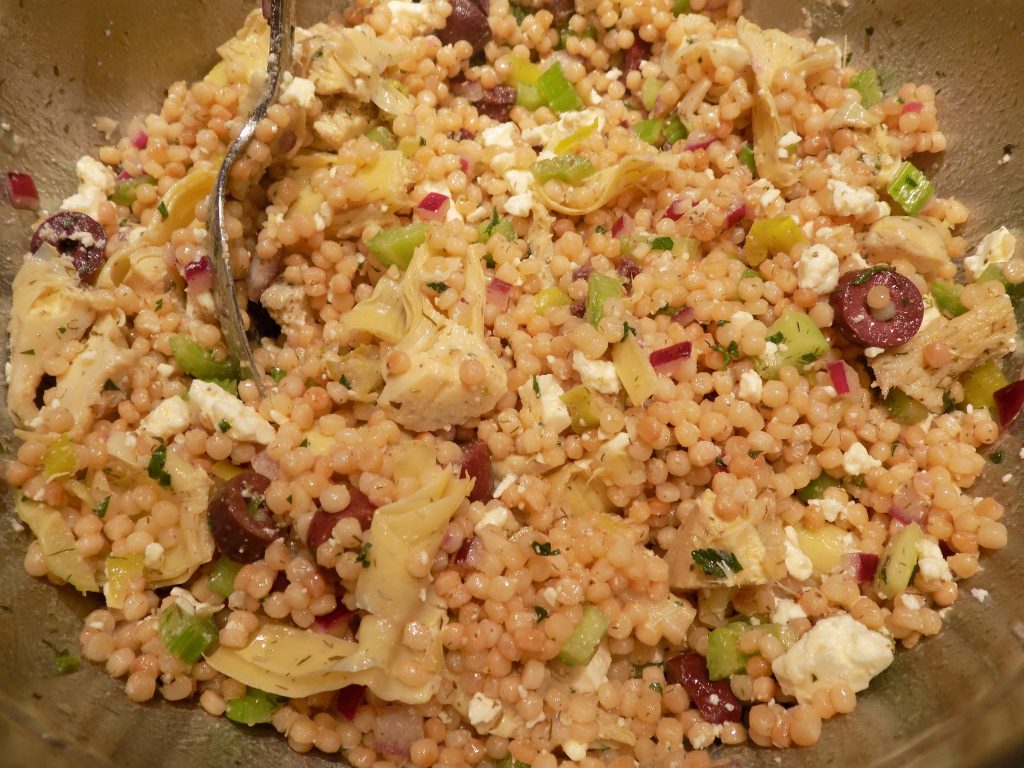
What to fix for dinner? That is often the first thought that hits me as I am reading the morning paper while sipping my Americano. You would think, with all the bad news coming out of Putin’s need to rule the world, that dinner would be the furthest thing from my mind. But unfortunately, I can do nothing to stop Putin, but I can do something about making sure our evening’s repast is enjoyable.
So, the other day, after breakfast, while I was whipping up the marinade for Quick and Easy Marinated Flank Steak, I thought a Mediterranean style salad with lots of strong flavors would fit the bill perfectly as an accompaniment. But I didn’t want a green salad. (I do get a bit tired of green salads.) So, how about a pasta salad? Nope, at least not one with the usual pasta suspects. But then I remembered I had some Israeli (pearl) couscous in the pantry. Voilà! Couscous tabbouleh it is! (And yes, couscous is a form of pasta. See a brief explanation below.)
So, with a new salad idea in mind, I went to work on creating the recipe you find below. Of course, I didn’t make it quite like the recipe indicates, because I was out of tomatoes and cucumber. And there was no going to the store for us because there was still an abundance of snow in our area. So, no tomatoes or cucumber. But I certainly will include them next time I make this dish.
So, I hope you enjoy this salad as much as we did. I do realize that there are more ingredients in this recipe than you normally find in a tabbouleh salad. But hey, I like bold flavors in my tabbouleh, hence the kalamata olives, pepperoncini, and feta cheese. But you of course can leave them out.
There is still snow on the ground after 4 days, which is quite unusual for us. But rain is in the forecast, so it might be gone by this evening or at the latest by tomorrow evening. Speaking of tomorrow, Mr. C. and I will be celebrating our 29th anniversary by attending a matinee and then dinner at one of our favorite restaurants. Good grief how the time has flown. But I wouldn’t have wanted it to fly by with anyone else. Mr. C. is my best friend, the kindest person anyone could ever hope to meet, and basically the love of my life. And he plays a wicked piano. Could any gal ask for more?
Peace and love to all.
For the vinaigrette:
⅓ c. extra virgin olive oil
2 T. fresh lemon juice
1 tsp. dill weed
2 garlic cloves, finely minced
½ tsp. seasoned salt
freshly ground black pepper
Whisk all ingredients together in a mixing bowl. Set aside until needed.
For the couscous:
1 T. extra virgin olive oil
1 c. pearl couscous
1 c. boiling water
1 tsp. vegetable base (I use Better Than Bouillon Vegetable base)
1 c. halved grape or cherry tomatoes
1 c. diced English cucumber
½ c. finely chopped celery
½ c. sliced kalamata olives
⅓ c. finely chopped red onion
⅓ c. chopped pepperoncini
2 T. chopped fresh parsley
1 (14-oz.) can artichoke hearts, roughly chopped
1 c. crumbled feta cheese
Heat the olive oil in a medium-sized, covered, heavy pot. Add the couscous and sauté until golden brown. Add the boiling water and vegetable base. Quickly cover the saucepan with a lid and let the couscous simmer for about 10 minutes undisturbed until it has fully absorbed the liquid. Remove the lid, fluff with a fork, and allow to come to room temperature.
In a large mixing bowl, combine the tomatoes, cucumber, celery, kalamata olives, red onion, pepperoncini, parsley, and artichoke hearts. Mix together. When cool, gently stir in the couscous.
Give the vinaigrette a quick whisk and add it to the couscous mixture. Mix well to combine. Adjust seasoning. Just before serving, mix in the crumbled feta.
*Couscous
According to the food network, “All couscous is made from semolina. Semolina is the name we give to flour that is ground from durum wheat. Durum wheat is a very hard wheat, higher in protein than the wheat all-purpose flour is made from. Semolina is golden yellow and gives couscous a nuttier taste than a pasta made with all-purpose flour. Keep in mind when using couscous that it is made from wheat and therefore, it’s not gluten-free.
Israeli couscous is made from the same semolina flour that Moroccan couscous is, but the balls of dough are larger and more consistently round.”
